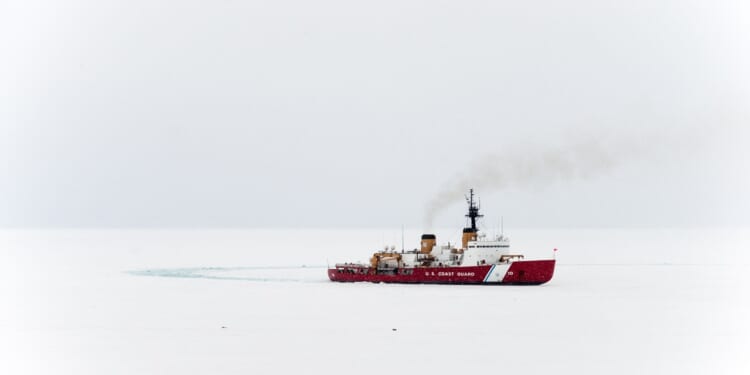The United States is effectively leapfrogging decades of woeful inattention to the Arctic.
For the last 18 years, the United States has all but ceded the Arctic to Russia. Since the moment the Russian Federation proudly—and defiantly—placed a miniature Russian flag on the seabed of the resource-rich Arctic Ocean, it has focused like a laser on dominating and developing the Arctic for its own purposes.
Moscow has been mostly successful in this endeavor. Indeed, now that Russia has a strong foothold in the region, it has developed the Northern Sea Route (NSR), a rival to the Suez Canal route for container ships cutting through the Arctic—to the point that China has joined Russia in utilizing this innovative sea route.
One of the key elements needed for dominating the Arctic region are icebreakers. Russia has eight nuclear-powered icebreakers in operation with an additional four on the way. The United States, meanwhile, has languished with merely four non-nuclear icebreakers. And there is little hope, given the limitations of America’s paralytic industrial base, that the United States will come anywhere near matching Russia’s advances.
Trump’s New Arctic Deal
Fortunately for the United States, President Donald Trump has a keen interest in Arctic security. Rather than simply abandon the rightful US claims to the High North, Trump is using whatever he can to remain competitive in that vital strategic domain.
Given that the Americans cannot produce their own icebreakers reliably, Trump is looking to purchase them from countries that can. Enter Finland’s President Alexander Stubb, with an offer to sell up to 11 “Arctic Security Cutters” to the United States Coast Guard.
The total price tag for the full order of 11 icebreakers is estimated to be over $6 billion. Finland will build the first four vessels in its own shipyards, leveraging Finnish design and Arctic experience. Next, the plan is to indigenize the construction of the remaining seven icebreakers by building them in the United States, with Finnish technical support and know-how transfer. The first of these icebreakers is slated to be delivered by 2028.
By purchasing icebreakers from Finland, the United States is effectively leapfrogging decades of woeful inattention to the Arctic. Whether the seven icebreakers set to be built in the United States at Davie (in Galveston, Tex.) and Bollinger (Houman, Louis.) will be built on schedule as planned, given the ever-diminishing state of America’s shipyards, is another matter. But even the initial tranche built in Finland will help to keep the Americans competitive in the High North.
Of course, China is also building a fleet of nuclear-powered icebreakers, too. Indeed, Beijing has already deployed two. And given China’s growing alliance with Russia in the High North, it is likely that soon Beijing will begin joint icebreaking missions with the Russians in the Arctic, seriously outnumbering even the increased Finnish-supplied American fleet of non-nuclear icebreakers.
Friendshoring and Onshoring in One Package
Trump has made the reindustrialization via onshoring a key component of his overall national trade and industrial agendas. By involving the Finns, Trump is both on-shoring and “friendshoring,” ensuring that the production of vital national security products are at least in a friendly country for the US to do business with. Still, the long-term plan is clearly to indigenize, rather than rely too much on an allied power—however friendly.
One question American policymakers should ask is: how much know-how will stay Finnish as the onshoring to the United States occurs? Will American shipyards really absorb that know-how, or remain technically dependent? There’s always a risk of “tech dumping,” or losing control over the advanced bits of the design. So, one must ask, which nation will end up owning the upgrades and critical subsystems?
This is the kind of deal that doesn’t just shift ships—it moves the balance of Arctic geopolitics (and enhances US technology production). Whoever controls the ice controls the naval lanes of the future, as global shipping and mineral resource development increasingly occurs in the High North.
About the Author: Brandon J. Weichert
Brandon J. Weichert is a senior national security editor at The National Interest. Recently, Weichert became the host of The National Security Hour on America Outloud News and iHeartRadio, where he discusses national security policy every Wednesday at 8pm Eastern. He is also a contributor at Popular Mechanics and has consulted regularly with various government institutions and private organizations on geopolitical issues. Weichert’s writings have appeared in multiple publications, including The Washington Times, National Review, The American Spectator, MSN, The Asia Times, and countless others. His books include Winning Space: How America Remains a Superpower, Biohacked: China’s Race to Control Life, and The Shadow War: Iran’s Quest for Supremacy. His newest book, A Disaster of Our Own Making: How the West Lost Ukraine is available for purchase wherever books are sold. He can be followed via Twitter @WeTheBrandon.
Image: Shutterstock / Brian L Stetson.


















